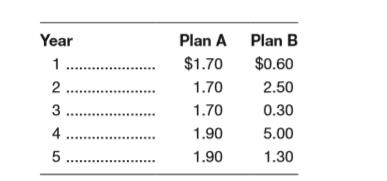
Concept explainers
In doing a five-year analysis of future dividends, the Dawson Corporation is considering the following two plans. The values represent dividends per share.

a. How much in total dividends per share will be paid under each plan over the five years?
b. Mr. Bright, the vice president of finance, suggests that stockholders often prefer a stable dividend policy to a highly variable one. He will assume that stockholders apply a lower discount rate to dividends that are stable. The discount rate to be used for Plan A is 11 percent; the discount rate for Plan B is 14 percent. Compute the
Want to see the full answer?
Check out a sample textbook solution
Chapter 18 Solutions
Foundations of Financial Management
- Given the following information concerning a convertible bond: a. What is the current yield of this bond? ANSWER: 4.8% b. What is the value of the bond based on the market price of the common stock? ANSWER: $864 c. What is the value of the common stock based on the market price of the bond? ANSWER: $38.52 d. What is the premium in terms of stock that the investor pays when he or she purchases the convertible bond instead of the stock? ANSWER: $176 e. Nonconvertible bonds are selling with a yield to maturity of 7 percent. If this bond lacked the conversion feature, what would the approximate price of the bond be? ANSWER: $817 f. What is the premium in terms of debt that the investor pays when he or she purchases the convertible bond instead of a nonconvertible bond? ANSWER: $223 g. If the price of the common stock should double, would the price of the convertible bond double? Briefly explain your answer. ANSWER: At least $1,728 h. If the price of the common stock should decline by 50…arrow_forwardI need help with financial accounting questionarrow_forwardI am looking for help with financial accounting questionarrow_forward
- Please Make Sure The Answer is correct. Answer provide With Financial Accounting methodarrow_forwardExplain how understanding the full cost of services important in public and nonprofit budgeting?arrow_forwardAgreee or disagree with post The temporary value of money (TVM) is an important concept in finance. TVM states that the money available now is worth more than the same amount in the future. This is because money can earn interest over time. A key assumption of this model is that money will obtain consistent performance. This assumption helps people make decisions about savings, investment and spending. For example, knowing that money grows can motivate people to save for future objectives. However, this model has limitations. The assumption of consistent yields may not be true in real life due to changes in the market or economic conditions. Therefore, although the temporal value of money is useful for planning, it is essential to consider the risks and uncertainties in financial decision making. Agree or disagree with postarrow_forward
- What is the time value of money concept? Explain one of the assumptions behind the TVM model. How does this assumption limit the application of this model?arrow_forwardagree or disagree with post TVM or time value of money is the suggestion that todays currency will be more profitable in the future. This concept comes from the action of investing, which produces returns and in short monopolizes the investment. One of the biggest assumptions behind the TVM model is that the economic conditions will remain steady enough to produce a profit for the consumer. This model does not account for inflation, fluctuation of the market, and even different government actions which can impact the economy. This limits the application of the model because it is not accurate and due it being based off of a growing interest rate only which we all know is not the case. Investing can be unpredictable and ever changing so that needs to be taken into account in models such as these. agree or disagree with postarrow_forwardHow are HRISs changing how companies manage their compensation and benefit plans?arrow_forward
 EBK CONTEMPORARY FINANCIAL MANAGEMENTFinanceISBN:9781337514835Author:MOYERPublisher:CENGAGE LEARNING - CONSIGNMENT
EBK CONTEMPORARY FINANCIAL MANAGEMENTFinanceISBN:9781337514835Author:MOYERPublisher:CENGAGE LEARNING - CONSIGNMENT

